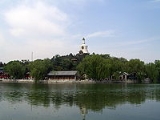
Beihai Park
Encyclopedia
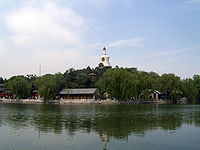
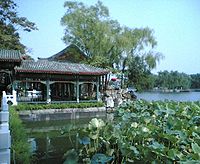

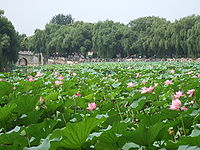

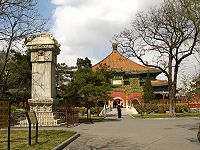
Forbidden City
The Forbidden City was the Chinese imperial palace from the Ming Dynasty to the end of the Qing Dynasty. It is located in the middle of Beijing, China, and now houses the Palace Museum...
in Beijing
Beijing
Beijing , also known as Peking , is the capital of the People's Republic of China and one of the most populous cities in the world, with a population of 19,612,368 as of 2010. The city is the country's political, cultural, and educational center, and home to the headquarters for most of China's...
. First built in the 10th century, it is amongst the largest of Chinese garden
Chinese garden
The Chinese garden, also known as a Chinese classical garden, is a style of landscape garden which has evolved for more than three thousand years, and which is inspired by Chinese literature, Chinese painting and Chinese philosophy...
s, and contains numerous historically important structures, palaces and temples. Since 1925, the place has been open to the public as a park. It is also connected at the south to the Shichahai
Shichahai
Shichahai is an historic scenic area consisting of three lakes in the north of central Beijing in China. They are located to the north-west of the Forbidden City and north-west of the Beihai Lake. Shichahai consists of the following three lakes: Qianhai , Xihai and Houhai...
.
The Park has an area of more than 69 hectare
Hectare
The hectare is a metric unit of area defined as 10,000 square metres , and primarily used in the measurement of land. In 1795, when the metric system was introduced, the are was defined as being 100 square metres and the hectare was thus 100 ares or 1/100 km2...
s, with a lake that covers more than half of the entire Park. At the center of the Park is an island called Qiónghuá (琼华) Island with a highest point of 32 m. In the north of the park there is a large pool called the Taiye Pool connecting the two other pools, which are called the Middle Sea and the South Sea respectively. Therefore the Taiye Pool is also called the Beihai.
Beihai literally means "Northern Sea". There are also corresponding "Central" and "Southern Seas" (Zhongnanhai
Zhongnanhai
Zhongnanhai is an area in central Beijing, China adjacent to the Forbidden City which serves as the central headquarters for the Communist Party of China and the State Council of the People's Republic of China. The term Zhongnanhai is closely linked with the central government and senior Communist...
). The complex of buildings around Zhongnanhai houses China's paramount leaders.
The Beihai Park, as with many of Chinese imperial gardens, was built to imitate renowned scenic spots and architecture from various regions of China; the taihu
Taihu
Taihu may refer to the following in China:*Taihu County , of Anqing, Anhui*Lake Tai , large freshwater lake on the borders of Jiangsu and Zhejiang provinces*Taihu, Beijing , town in Tongzhou District, Beijing...
lake, the elaborate pavilion
Pavilion (structure)
In architecture a pavilion has two main meanings.-Free-standing structure:Pavilion may refer to a free-standing structure sited a short distance from a main residence, whose architecture makes it an object of pleasure. Large or small, there is usually a connection with relaxation and pleasure in...
s and canals in Hangzhou
Hangzhou
Hangzhou , formerly transliterated as Hangchow, is the capital and largest city of Zhejiang Province in Eastern China. Governed as a sub-provincial city, and as of 2010, its entire administrative division or prefecture had a registered population of 8.7 million people...
and Yangzhou
Yangzhou
Yangzhou is a prefecture-level city in central Jiangsu Province, People's Republic of China. Sitting on the northern bank of the Yangtze River, it borders the provincial capital of Nanjing to the southwest, Huai'an to the north, Yancheng to the northeast, Taizhou to the east, and Zhenjiang across...
, the delicate garden structures in Suzhou
Suzhou
Suzhou , previously transliterated as Su-chou, Suchow, and Soochow, is a major city located in the southeast of Jiangsu Province in Eastern China, located adjacent to Shanghai Municipality. The city is situated on the lower reaches of the Yangtze River and on the shores of Taihu Lake and is a part...
and others all served as inspirations for the design of the numerous sites in this imperial garden. The structures and scenes in the Beihai Park are described as masterpieces of gardening technique that reflects the style and the superb architectural skill and richness of traditional Chinese garden art.
Notable places
The Bai Ta (White Dagoba) is a 40 m high stupaStupa
A stupa is a mound-like structure containing Buddhist relics, typically the remains of Buddha, used by Buddhists as a place of worship....
placed on the highest point on Qiónghuá Island. Its body is made of white stone. Sun, moon and flame engravings decorate the surface of the tower. Destroyed in 1679 by an earthquake, it was rebuilt the following year, and restored again in 1976, because of an earthquake which occurred at Tangshan
1976 Tangshan earthquake
The Tangshan Earthquake also known as the Great Tangshan Earthquake, was a natural disaster that occurred on July 28, 1976. It is believed to be the largest earthquake of the 20th century by death toll. The epicenter of the earthquake was near Tangshan in Hebei, People's Republic of China, an...
, near Beijing. A reliquary
Reliquary
A reliquary is a container for relics. These may be the physical remains of saints, such as bones, pieces of clothing, or some object associated with saints or other religious figures...
, secreted inside the structure are Buddhist Scriptures, monk's mantles and alms bowl, and the bones of monks (their remains after cremation).
There are several renowned Buddhist temples located within Beihai Park, such as the Yong'an Temple (Temple of Everlasting Peace) and the Chanfu Temple.
On the north bank lies the Five-Dragon Pavilions, five connected pavilions with spires and pointed upswept eaves, which was built in the Ming Dynasty
Ming Dynasty
The Ming Dynasty, also Empire of the Great Ming, was the ruling dynasty of China from 1368 to 1644, following the collapse of the Mongol-led Yuan Dynasty. The Ming, "one of the greatest eras of orderly government and social stability in human history", was the last dynasty in China ruled by ethnic...
.
The Nine-Dragon Wall
Nine-Dragon Wall
A Nine-Dragon Wall or Nine-Dragon Screen is a type of screen wall with reliefs of nine different Chinese dragons...
lies north of the Five-Dragon Pavilion. It was built in 1402 and is one of three walls of its kind in China. It is made of glaze bricks of seven-colors. Nine complete dragons playing in the clouds decorate both sides of the wall.
Also on the north bank is the Jingxin Room (Quieting Heart Room). It is a garden within the garden, and covers an area of more than 4,000 m². Many small traditional Chinese gardens exist throughout the park.
The Circular Wall (Tuancheng) has as its main structure the Hall of Received Light (Chengguangdian), a spacious building with a double-eaved roof made of yellow glazed tiles bordered in green. Inside there is a 1.6 m tall Buddha
Buddharupa
Buddharūpa is the Sanskrit and Pali term used in Buddhism for statues or models of the Buddha.-Commonalities:...
presented to Emperor Guangxu by a Cambodia
Cambodia
Cambodia , officially known as the Kingdom of Cambodia, is a country located in the southern portion of the Indochina Peninsula in Southeast Asia...
n (Khmer) king. It is carved from a single piece of pure white jade inlaid with precious stones. The Eight-Nation Alliance
Eight-Nation Alliance
The Eight-Nation Alliance was an alliance of Austria-Hungary, France, Germany, Italy, Japan, Russia, the United Kingdom, and the United States whose military forces intervened in China to suppress the anti-foreign Boxers and relieve the siege of the diplomatic legations in Beijing .- Events :The...
damaged the statue’s left arm in the Battle of Peking
Battle of Peking
The Battle of Peking, or the Relief of Peking, was the battle on 14–15 August 1900 in which a multi-national force relieved the siege of foreign legations in Peking during the Boxer Rebellion...
in 1900.
In the Beihai Park, one could find Taihu
Taihu
Taihu may refer to the following in China:*Taihu County , of Anqing, Anhui*Lake Tai , large freshwater lake on the borders of Jiangsu and Zhejiang provinces*Taihu, Beijing , town in Tongzhou District, Beijing...
rocks shipped from the Henan province and a variety of art collections ranging from jade jars from the Yuan-era to a collection of 495 steles bearing inscriptions by trees of hundreds of years old.

